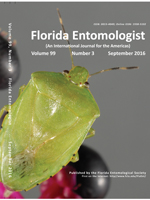Growth, oviposition, and survival rates of the bromeliad-eating weevil Metamasius callizona (Chevrolat) (Coleoptera: Curculionidae) were measured at a range of temperatures to determine optimal temperature range, lower and upper development thresholds, and degree-days needed for development of immature stages. Optimal temperature range for growth was 25 to 30 °C and for oviposition 22 to 33 °C. The lower development threshold was 13 °C and upper threshold about 35 °C. Development of the egg and larval stages required 518 degree-days, and from pupation to adult 140 degree-days. Adult weevils suffered higher mortality at 35 °C than at 25 or 16 °C. Typical winter conditions likely have at most a minimal effect on weevil populations in central Florida and no effect in southern Florida. As well, high summer temperatures could potentially cause weevil mortality due to heat stupor but, as with winter temperatures, the effects would be minimal. Extremely cold winters and extremely high summer temperatures may cause high weevil mortality, particularly in central Florida. Sea breezes on the east coast of Florida may create cooler habitats during the summer and therefore ameliorate mortality due to summer temperatures.
How to translate text using browser tools
1 September 2016
Effect of Temperature on Growth, Reproductive Activity, and Survival of the Invasive Bromeliad-Eating Weevil Metamasius callizona (Coleoptera: Curculionidae)
Teresa M. Cooper,
Ronald D. Cave

Florida Entomologist
Vol. 99 • No. 3
September 2016
Vol. 99 • No. 3
September 2016
degree day
development threshold
día-grado
Florida
optimal temperature range
rango optimal de temperatura
Tillandsia




